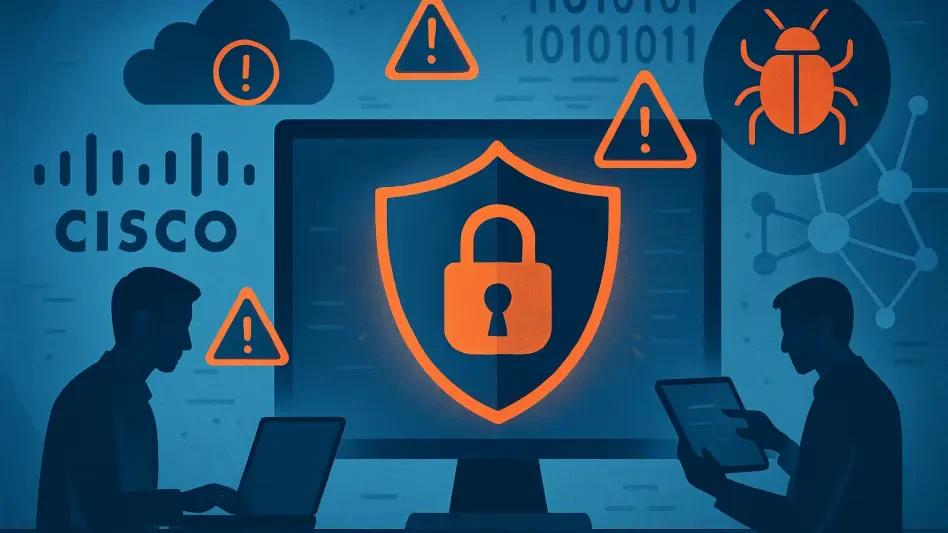In a startling revelation this September, a grave cybersecurity crisis has unfolded with the discovery of state-sponsored actors actively exploiting zero-day vulnerabilities in Cisco Adaptive Security Appliance (ASA) and Firepower Threat Defense (FTD) software, posing a severe threat to global government networks. These previously undisclosed flaws have become a gateway for sophisticated adversaries to target these networks, intensifying a campaign identified as “ArcaneDoor.” With edge devices such as firewalls and VPN gateways under siege, the attackers aim to extract sensitive data while employing cutting-edge evasion tactics to remain undetected. This article delves into the heart of this urgent threat, exploring the nature of the vulnerabilities, the cunning adversary orchestrating the attacks, and the worldwide efforts to curb the fallout. The stakes are extraordinarily high, as these exploits pose a direct risk to critical infrastructure and national security, demanding immediate attention from organizations relying on Cisco’s widely used security solutions.
Unmasking the Adversary of ArcaneDoor
A formidable state-sponsored threat actor, tied to the ongoing ArcaneDoor campaign, stands as the orchestrator of these alarming cyberattacks. With a clear focus on government networks worldwide, the adversary’s primary objective appears to be the extraction of highly sensitive data, likely driven by geopolitical motives. Their ability to operate under the radar is particularly concerning, as advanced evasion techniques—such as disabling logging mechanisms—allow them to bypass conventional detection systems with precision. By targeting edge devices that form the boundary between internal networks and the public internet, this actor exploits the inherent trust placed in these critical defenses, turning protective barriers into points of vulnerability. The strategic selection of such targets underscores a calculated approach to infiltrate systems that hold invaluable information.
The sophistication of this threat actor extends beyond mere technical prowess, reflecting a deep understanding of the systems they attack. Edge devices, often seen as the first line of defense, become the perfect entry point for stealthy access to broader networks. Government entities, with their vast repositories of classified and operational data, represent high-value targets for such an adversary. The use of zero-day vulnerabilities, unknown to vendors and security teams prior to exploitation, amplifies the challenge of mounting an effective defense. This situation highlights not only the immediate danger posed by this specific campaign but also the broader implications of state-sponsored cyber operations that prioritize stealth and persistence over overt disruption.
Dissecting the Critical Vulnerabilities
At the core of this cybersecurity crisis lie three severe vulnerabilities within Cisco ASA and FTD software, two of which are already being actively exploited. Labeled as CVE-2025-20333 with a critical CVSS score of 9.9 and CVE-2025-20362 with a medium score of 6.7, these flaws grant attackers the ability to execute arbitrary code and gain unauthorized access to restricted VPN endpoints. A third vulnerability, CVE-2025-20363, rated critical at 9.0, stands as a looming threat with high potential for future exploitation. The impact of these weaknesses cannot be overstated, as they enable devastating consequences such as the implantation of persistent malware capable of surviving device reboots. Given the role of affected devices in securing network perimeters, the risks are exponentially magnified, threatening the integrity of entire systems.
The technical implications of these vulnerabilities reveal a profound challenge for organizations dependent on Cisco’s security solutions. Arbitrary code execution allows attackers to take full control of compromised devices, potentially using them as footholds for deeper network penetration. Unauthorized access to VPN endpoints further compounds the issue, as it bypasses authentication mechanisms meant to safeguard remote connections. The persistence of malware through reboots indicates a level of sophistication that ensures long-term access for attackers, even in the face of routine system maintenance. As these flaws target edge devices critical to network security, the potential for data breaches and operational disruptions grows, demanding urgent action to prevent widespread fallout across affected sectors.
The Dangerous Lifecycle of Zero-Day Exploits
Zero-day vulnerabilities follow a perilous trajectory that begins with exclusive exploitation by highly capable nation-state actors, as seen in the ArcaneDoor campaign. These initial attacks are meticulously crafted, leveraging unknown flaws to achieve specific strategic objectives, often tied to espionage or data theft. However, once the details of such vulnerabilities surface—whether through reverse-engineering by other groups or disclosures from vendors like Cisco—the landscape shifts dramatically. Less skilled cybercriminals seize the opportunity to develop simpler, yet still destructive, exploits aimed at financial gain rather than geopolitical advantage. This secondary wave of attacks frequently targets unpatched systems, exploiting delays in update deployment to maximize damage across a broader range of victims.
This cascading effect transforms a targeted threat into a potential global epidemic, creating a stark “patch-or-perish” scenario for organizations. The transition from sophisticated, state-sponsored operations to widespread criminal activity underscores the urgency of timely mitigation. Systems left unpatched become low-hanging fruit for opportunistic attackers who may lack the resources of nation-states but can still inflict significant harm through ransomware or data breaches. The lifecycle of zero-day exploits thus serves as a stark reminder of the interconnected nature of cyber threats, where an initial breach by a single actor can ripple outward, affecting entities far beyond the original scope of the attack. This dynamic necessitates rapid response mechanisms to close vulnerabilities before they are weaponized on a larger scale.
Coordinated Global Efforts to Mitigate Risks
In response to this escalating threat, Cisco took decisive action by releasing software updates on September 25 to address all three identified vulnerabilities, accompanied by a strong recommendation for immediate patching. The urgency of the situation prompted the U.S. Cybersecurity and Infrastructure Security Agency (CISA) to issue Emergency Directive 25-03, compelling federal agencies to mitigate risks swiftly due to the profound danger to critical infrastructure. Meanwhile, the U.K.’s National Cyber Security Centre (NCSC) contributed valuable insights through a comprehensive malware analysis, detailing the persistence and communication strategies employed by the attackers. Industry partners, such as Palo Alto Networks, have also provided temporary mitigation guidance for systems unable to update immediately, though these measures come with operational trade-offs like disabling VPN services.
The collaborative nature of the global response reflects a shared recognition of the severity of this cybersecurity challenge. Cisco’s updates serve as the first line of defense, aiming to close the exploitable gaps in ASA and FTD software before further damage occurs. CISA’s directive underscores the immediate implications for national security, ensuring that government entities prioritize remediation to protect sensitive operations. The NCSC’s technical analysis offers a deeper understanding of the threat, equipping organizations with knowledge to detect and counter specific attack patterns. While temporary mitigations from industry players provide a stopgap for some, they also highlight the complexities of balancing security with functionality, pushing the need for long-term strategies to address such vulnerabilities comprehensively.
Technical Insights into Malware and Attack Methods
Delving into the technical underpinnings of these attacks reveals a chilling level of sophistication in the tools deployed by the ArcaneDoor adversary. RayInitiator, identified as a multi-stage bootkit, ensures persistence by surviving reboots and firmware upgrades, embedding itself deeply within affected systems. LINE VIPER, a shellcode loader, targets specific Cisco ASA models lacking secure boot capabilities, further enabling unauthorized control. Command-and-control (C2) communications are conducted over HTTPS or ICMP, with responses delivered via raw TCP, allowing attackers to blend seamlessly with legitimate network traffic. Such tactics demonstrate a deliberate effort to evade detection, posing significant challenges for traditional security measures reliant on recognizable patterns of malicious activity.
Further aiding defenders, Unit 42 from Palo Alto Networks has developed detection tools, including hunting queries for Cortex XDR and XSIAM users, to identify disruptions in logging—a critical indicator of compromise in Cisco ASA devices. These disruptions often signal that attackers have disabled logging to cover their tracks, a tactic that complicates forensic analysis and incident response. The detailed understanding of malware behavior and communication methods provided by such tools equips organizations with actionable intelligence to spot and mitigate threats early. This technical perspective emphasizes the evolving nature of cyber adversaries, who continuously adapt their methods to exploit vulnerabilities in ways that challenge even the most robust defenses, necessitating advanced detection and response strategies.
Emerging Patterns in Cyber Threat Landscapes
This incident is emblematic of a larger trend where nation-state actors increasingly target edge devices with zero-day vulnerabilities to secure undetected access to networks. Firewalls and VPN gateways, designed to shield internal systems, become critical weaknesses when exploited, offering a direct conduit to sensitive environments. The strategic focus on these perimeter defenses reflects an understanding of their pivotal role in network architecture, making them prime targets for adversaries seeking to bypass traditional security layers. As such attacks grow in frequency, they expose systemic risks within infrastructures that rely heavily on edge devices to maintain operational integrity and data confidentiality.
Moreover, the use of evasion techniques like disabling logging points to a shift toward more covert attack methodologies that challenge conventional cybersecurity approaches. This trend is compounded by the potential for initial, sophisticated breaches to enable subsequent waves of opportunistic attacks by less advanced threat actors. The resulting complexity of the threat landscape demands a reevaluation of defensive priorities, emphasizing the need for enhanced visibility into edge device activity and more resilient security frameworks. As nation-state tactics set the stage for broader exploitation, the cybersecurity community must adapt to address not only immediate threats but also the cascading effects that follow, ensuring protections keep pace with evolving adversary capabilities.
Strategic Implications and Path Forward
The active exploitation of zero-day flaws in Cisco ASA and FTD software carries profound implications, particularly for government entities and critical infrastructure sectors reliant on these technologies. The involvement of a state-sponsored actor raises the specter of significant data loss and operational disruptions, with potential consequences for national security and public safety. Beyond the primary targets, the risk of broader exploitation by cybercriminals looms large, threatening any organization with unpatched systems. Immediate action to apply Cisco’s updates is paramount, alongside the use of detection tools to uncover early signs of compromise, ensuring that vulnerabilities are addressed before they can be fully exploited.
Looking ahead, this crisis serves as a critical reminder of the importance of proactive vulnerability management and robust monitoring of edge devices. Organizations must establish rapid response capabilities to address emerging threats, integrating regular software updates into their security protocols to minimize exposure. Collaboration with government bodies and industry partners, as demonstrated in the coordinated response to this incident, enhances preparedness and resource sharing, creating a more resilient cybersecurity ecosystem. By learning from this event, entities can better anticipate future risks, investing in strategic defenses that prioritize both immediate mitigation and long-term prevention to safeguard against the evolving tactics of sophisticated adversaries.








